Introduction: The Secret to a Menu That Sells
A restaurant menu isn’t just a list of dishes—it’s a sales tool, branding asset, and customer experience enhancer all in one. A well-designed menu guides customers’ choices, increases average order value, and reinforces your restaurant’s identity. In this tutorial, we’ll walk you through the essential steps to create a high-converting, visually appealing menu for your restaurant.
Step 1: Define Your Menu Layout
Before diving into design, decide how you want to structure your menu. A good layout should be organized, easy to scan, and strategically arranged to highlight high-profit items.
📌 Key tips:
✔️ Use sections (Appetizers, Entrees, Desserts, Beverages) for easy navigation.
✔️ Place your most profitable items in the top right section (the “Golden Triangle” area where customers’ eyes naturally land first).
✔️ Avoid overcrowding—a cluttered menu overwhelms customers and reduces sales.
Step 2: Choose the Right Fonts & Colors
Typography and color choices set the tone for your brand. Whether your restaurant is elegant, casual, or fast-paced, your menu design should match.
🎨 Best Practices:
✔️ Stick to 2-3 complementary fonts for readability.
✔️ Use bold or italicized text to highlight key dishes, but don’t overdo it.
✔️ Select colors that align with your branding—warm colors (red, orange) stimulate appetite, while green and earth tones suggest freshness.
Step 3: Write Descriptive & Persuasive Dish Names
Great menu descriptions don’t just list ingredients—they tell a story and evoke emotions.
🍽️ How to improve your descriptions:
❌ Instead of: “Grilled Chicken with Vegetables”
✅ Try: “Juicy Char-Grilled Chicken Served with Farm-Fresh Roasted Vegetables”
📌 Bonus Tip: Use sensory words like “crispy,” “succulent,” “flavor-packed,” or “slow-cooked” to make dishes sound irresistible.
Step 4: Use High-Quality Images Strategically
Including mouthwatering photos can increase sales by up to 30%, but too many images can make a menu look cluttered and cheap.
📷 Best Practices for Menu Images:
✔️ Feature only your top-selling or signature dishes with professional photos.
✔️ Keep a consistent style—avoid using low-quality or stock images.
✔️ Place images next to high-margin items to subtly guide customer choices.
Step 5: Optimize for Pricing Psychology
How you display prices can influence how customers perceive value.
💰 Smart pricing strategies:
✔️ Avoid using dollar signs ($)—psychological studies show that removing currency symbols makes customers spend more.
✔️ Consider “charm pricing” (e.g., $9.95 instead of $10) to make prices seem lower.
✔️ Use “decoy pricing”—offering a high-priced dish next to a slightly cheaper one makes the latter seem like a great deal.
Step 6: Print & Test Your Menu
Before finalizing your menu, print a sample and test it in your restaurant. Observe how customers interact with it—are they struggling to find certain items? Do they skip over important sections? Adjust as needed based on customer feedback and sales data.
📌 Bonus Tip: Consider laminated or waterproof menus for durability, or QR code digital menus for easy updates.
Conclusion: Make Your Menu Work for You
Your restaurant’s menu is one of your most powerful marketing tools. By following these steps, you can create a menu that’s not only aesthetically appealing but also optimized for sales.
💡 Need professional menu printing? We offer custom-designed, high-quality menus that match your restaurant’s branding. Contact us today to get started!




